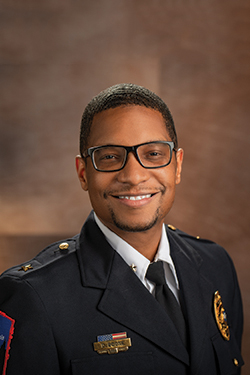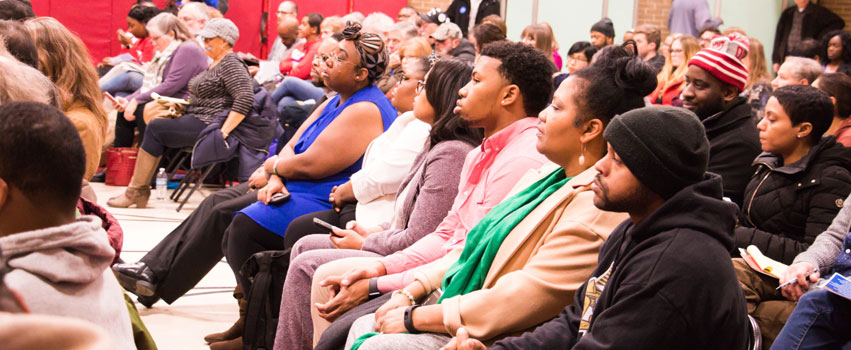Curing the Other “COVID”

I will always remember the day COVID-19 hit the news. No matter where you were on the planet, you were affected. Our lives, health, finances… everything was at stake. How did we respond? The entire earth paused to address one of the greatest crises in history. We shut everything down, put our best and brightest on a cure, shared resources, bailed out businesses, provided a stimulus, and pressed for a vaccine to be freely distributed.
We put everything we had into stopping this disease. No cost was too great to stop COVID-19.
When we respond immediately to a crisis, we can see the potential for solutions. Yet there is another “COVID”—a disease we have allowed to lie dormant. It has sickened Peoria, it has weakened America, and it has been left to spread unchecked. This disease is called redlining.
When we look at the local news today, it sounds not unlike the symptoms of COVID-19. The loss of Caterpillar (loss of taste and smell). One of the worst places to live for African Americans (respiratory problems). The 15th most homicides in the country per capita (extreme exhaustion). Financial woes (fever and chills). Whenever one of these “symptoms” rears its ugly head, a quick glance at the news or social media confirms that we have not begun to address the roots of the redlining virus.
We seem to not understand the answers to those nagging issues. Why is 61605 in the shape it is? Why the serious violent crime in Peoria? Why the blight in specific areas? Why the mental health issues? Why the policing concerns? Why do those teenagers fight at the mall or event center? These are all symptoms of that other COVID.
So how will we respond? We can break it down like we responded to COVID-19.
Redlining – Locating the Source
Redlining is defined as “the systematic denial of various services or goods by governments or the private sector either directly or through the selective raising of prices.” It typically refers to real estate, insurance and financial loans—the refusal to service someone because they live in an area deemed to be “risky” or “hazardous.”
The practice started in the early 1930s, as families were systematically denied the right to purchase homes and live where they wanted. Neighborhoods in Peoria—and nationwide—were color-coded to depict designated areas: Green = “Best.” Blue = “Still Desirable.” Yellow = “Definitely Declining.” Red = “Hazardous.” It extended to the lack of local grocery stores and other vital services (though never shy a liquor store)—and little to no medical or mental healthcare services in an area.
The redlining virus carried the symptoms of the other “COVID” that Peoria and the rest of America took in like a shot to the vein. With the foundation of this disease set, our symptoms grew across generations.
The Map – Pinpointing the Disease
When we look at the historical map of redlined areas in Peoria, it eerily mimics the exact areas that are experiencing the most severe symptoms today. The answers to the above questions can be found right there in the virus.
When people are denied homeownership or restricted to specific “hazard” areas per racial covenants (as recently as the 1970s in Peoria), they are denied the opportunity to transfer wealth generationally. As such, the practice of redlining solidified disinvestment in specific people and areas. Some can overcome this disadvantage; others are never able to—and most inherit trauma from trying to fight out of it. But all of us are exposed to this manmade virus, no matter where you live or work.
The Effect – Explaining the Symptoms
The symptoms of this virus encompass many of the major issues within our city. High crime rate and shootings? The disinvestment in redlined communities caused this blight and despair. When all you see in some neighborhoods are boarded-up houses, the lack of healthy food in local grocery stores (or no grocery store at all), and the absence of businesses, it pushes some to resort to any means necessary just to survive.
Little to no homeownership in a specific area? Halting that family transfer of wealth has caused enormous generational wealth gaps. When families cannot get a head start on building credit, obtaining homeownership or passing down wealth, they are significantly disadvantaged in life. Denied these basic privileges, their children and grandchildren are kept in perpetual poverty.
Peoria’s children fighting and venting rage? It’s tied to the traumas of broken families forced into the PTSD of living in overpoliced warzones, fighting to get out of those 1930s-era “hazardous” areas. Any human living this way will be forever scarred by it. The traumas of the fight to get out—and the struggles of life while in the fight—are always there. To this day, trauma still lives within me personally, having grown up in South Peoria. This explains the rage, the anger, the mental health crisis.
All of these effects are tied to the redlining virus that our society intentionally injected itself with. A virus that does not just stay in the arm we injected, but spreads to the heart, the lungs and the brain. All of Peoria shall be affected if no vaccine is sought.
The Solution: Creating the Vaccine
So what is the vaccine? The beginnings of a cure? We attack the disease with the same effort we did with COVID-19. We fight to find the source, understand the disease, diagnose the symptoms, and put a full-court press on a vaccine, no matter the cost. Federal, state and city governments must push to inject a vaccine that contains intentional investment, direct mental health services, a comprehensive plan to expand homeownership, investment in public education, financial literacy, and the list goes on.
There must be an intentional push in Peoria—and across the nation—to fix the “COVID” that was purposeful in its injection. Instead of getting stuck on what the symptoms are, Peoria can steam ahead on injecting a direct cure to stop the virus in its tracks. A vaccine with purpose. A vaccine that will not only cure where the virus was injected, but where it will spread if we keep our heads in the sand. PM
